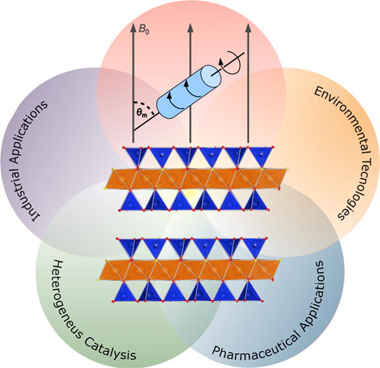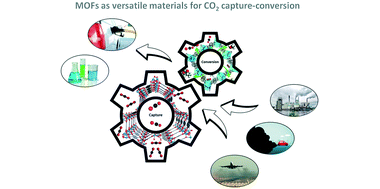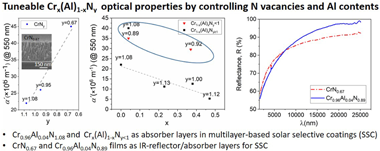Scientific Papers in SCI
2021
2021
Materiales de Diseño para la Energía y Medioambiente
Swelling layered minerals applications: A solid state NMR overview
Pavon, E; Alba, MDProgress in Nuclear Magnetic Resonance Spectroscopy, 124 (2021) 99-128
Show abstract ▽

Swelling layered clay minerals form an important sub-group of the phyllosilicate family. They are characterized by their ability to expand or contract in the presence or absence of water. This property makes them useful for a variety of applications, ranging from environmental technologies to heteroge-neous catalysis, and including pharmaceutical and industrial applications. Solid State Nuclear Magnetic Resonance (SS-NMR) has been extensively applied in the characterization of these materials, providing useful information on their dynamics and structure that is inaccessible using other characterization methods such as X-ray diffraction. In this review, we present the key contributions of SS-NMR to the understanding of the mechanisms that govern some of the main applications associated to swelling clay minerals. The article is divided in two parts. The first part presents SS-NMR conventional applications to layered clay minerals, while the second part comprises an in-depth review of the information that SS-NMR can provide about the different properties of swelling layered clay minerals.
June, 2021 | DOI: 10.1016/j.pnmrs.2021.04.001
Química de Superficies y Catálisis
Understanding the opportunities of metal-organic frameworks (MOFs) for CO2 capture and gas-phase CO2 conversion processes: a comprehensive overview
Gandara-Loe, J; Pastor-Perez, L; Bobadilla, LF; Odriozola, JA; Reina, TRReaction Chemistry & Engineering, 6 (2021) 787-814
Show abstract ▽

The rapid increase in the concentration of atmospheric carbon dioxide is one of the most pressing problems facing our planet. This challenge has motivated the development of different strategies not only in the reduction of CO2 concentrations via green energy alternatives but also in the capture and conversion of CO2 into value-added products. Metal-organic frameworks (MOFs) are a relatively new class of porous materials with unique structural characteristics such as high surface areas, chemical tunability and stability, and have been extensively studied as promising materials to address this challenge. This comprehensive review identifies the specific structural and chemical properties of MOFs that result in advanced CO2 capture capacities and fairly encouraging catalytic CO2 conversion behaviour. More importantly, we describe an interconnection among the unique properties of MOFs and the engineering aspects of these intriguing materials towards CO2 capture and conversion processes.
May, 2021 | DOI: 10.1039/d1re00034a
Mössbauer study of iron gall inks on historical documents
Lerf, A; Wagner, FE; Dreher, M; Espejo, T; Perez-Rodriguez, JLHeritage Science, 9 (2021) 49
Show abstract ▽
Iron gall ink was used in the Western world as a permanent writing material already in late Roman times and throughout the Middle Ages, until it became obsolete in the twentieth century. There is much interest in experimental methods to determine the state of the ink and its degradation products on historical documents. Mossbauer spectroscopy with Fe-57 is such a method, and it has the particular advantage to be sensitive to the chemical bonding of iron, but this method has only rarely been applied to historical documents. In this paper we present Mossbauer data for two damaged documents from a Library in Granada and a handwritten German book from the eighteenth century. In addition to the inked parts of the manuscripts, ink-free parts were studied to determine the amount and chemical state of the iron in the papers. These new results are discussed in the context of previously published Mossbauer data. In one of the investigated documents Fe(II)-oxalate, FeC2O4 center dot 2H(2)O, was observed. The assignment of the various Fe3+ sites in the different documents is rather difficult and often there is a superposition of various species. Known forms of iron gallate are definitely not present on the inked papers. The observed ferric species can be remains of Fe3+ polyphenol complexes of the ink, complexes of Fe3+ with degradation products of the cellulose of the paper or gum arabic, or very small iron oxide or hydroxide nanoparticles.
May, 2021 | DOI: 10.1186/s40494-021-00522-3
Tribología y Protección de Superficies - Materiales Ópticos Multifuncionales
High-temperature solar-selective coatings based on Cr(Al)N. Part 1: Microstructure and optical properties of CrNy and Cr1-xAlxNy films prepared by DC/HiPIMS
Rojas, TC; Caro, A; Lozano, G.; Sanchez-Lopez, JCSolar Energy Materials and Solar Cells, 223 (2021) 110951
Show abstract ▽

In order to explore the potentialities of Cr1-x(Al)xNy materials in multilayer-based solar selective coatings (SSC) for high temperature applications (T > 500 °C), the optical behavior of Cr1-x(Al)xNy films is studied in this work. Two sets of layers (CrNy and Cr1-xAlxNy) were prepared by direct current (DC) and high-power impulse magnetron sputtering (HiPIMS) technology. The deposition parameters: N2 flux, HiPIMS frequency and aluminum sputtering power, were modified to get a wide variety of stoichiometries. The composition, morphology, phases and electronic structure of the films were characterized in depth. The optical behavior was determined by UV–Vis–NIR and FTIR spectroscopies, and the optical constants were obtained from the measured transmittance and reflectance spectra based on appropriate dielectric function models. Our results indicate that small changes in the layer composition influence the optical constants. In particular, a metallic-like behavior was obtained for CrNy layers with N vacancies (CrN0.95 and CrN0.67 films) while a semiconductor-like behavior was observed for CrN1.08. Thus, the CrNy films can be used as effective absorber layer in multilayer-based SSC, and namely, the CrN0.67 film as an IR reflector/absorber layer too. Likewise, the optical properties of Cr1-xAlxNy layers can also be tuned from metallic to semiconductor-like behavior depending on the chemical composition. Indeed, the absorption coefficients of Cr1-xAlxNy films with optimized Al content and N-vacancies are comparable to those reported for state-of-the-art materials such as TiAlN or TiAlCrN. In addition, a Cr0.96Al0.04N0.89 film was found to be a suitable IR reflector/absorber layer.
May, 2021 | DOI: 10.1016/j.solmat.2020.110951
Reactividad de Sólidos
Synthesis and Characterization of a Nearly Single Bulk Ti2AlN MAX Phase Obtained from Ti/AlN Powder Mixture through Spark Plasma Sintering
Salvo, C; Chicardi, E; Poyato, R; Garcia-Garrido, C; Jimenez, JA; Lopez-Pernia, C; Tobosque, P; Mangalaraja, RVMaterials, 14 (2021) 2217
Show abstract ▽
MAX phases are an advanced class of ceramics based on ternary carbides or nitrides that combine some of the ceramic and metallic properties, which make them potential candidate materials for many engineering applications under severe conditions. The present work reports the successful synthesis of nearly single bulk Ti2AlN MAX phase (>98% purity) through solid-state reaction and from a Ti and AlN powder mixture in a molar ratio of 2:1 as starting materials. The mixture of Ti and AlN powders was subjected to reactive spark plasma sintering (SPS) under 30 MPa at 1200 degrees C and 1300 degrees C for 10 min in a vacuum atmosphere. It was found that the massive formation of Al2O3 particles at the grain boundaries during sintering inhibits the development of the Ti2AlN MAX phase in the outer zone of the samples. The effect of sintering temperature on the microstructure and mechanical properties of the Ti2AlN MAX phase was investigated and discussed.
May, 2021 | DOI: 10.3390/ma14092217
- ‹ previous
- 76 of 410
- next ›














